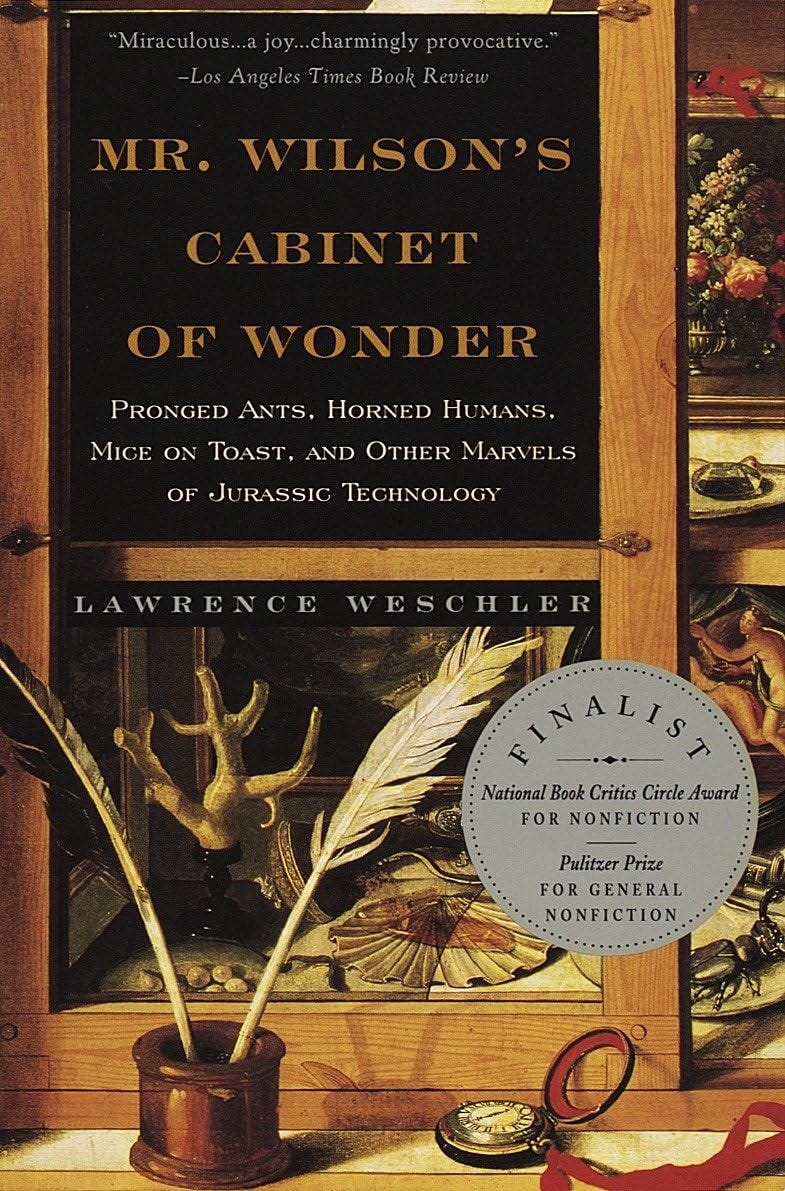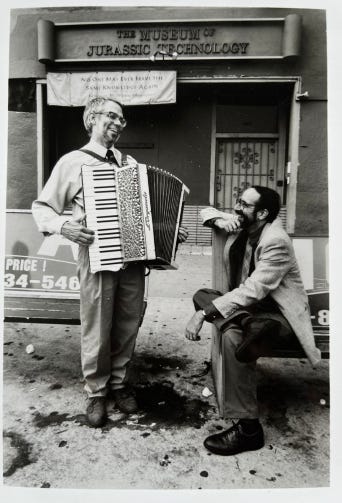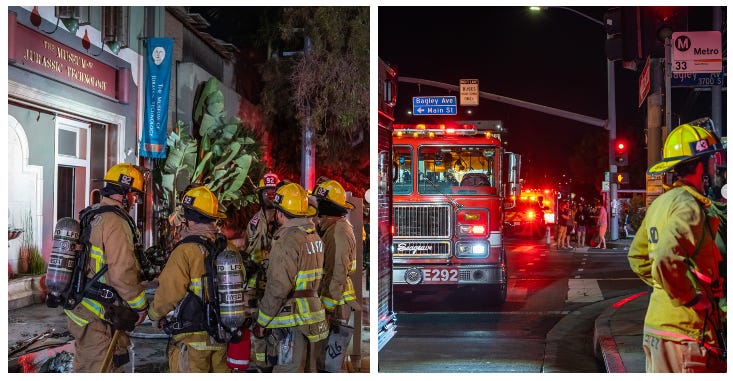July 17, 2025 : Wondercab Mini (94A)
SOS: FIRE AT THE MJT
Many readers of this particular Substack may already realize that its very name—“Wondercabinet”—wends back, in terms of my own lifework, to my days covering the then-barely-nascent Museum of Jurassic Technology, for what became my 1995 book Mr. Wilson’s Cabinet of Wonder. I say “barely nascent,” but in fact the MJT was born “age-old,” and as many noted, in at least one of its aspects, seems a veritable reincarnation of one of those sixteenth century Wunderkammers it itself so clearly reveres, this is an otherwise conventional swath of the Culver City neighborhood of West Los Angeles—with its founder, David Wilson, being a sort of Athanasius Kircher Redux, or Ole Worm, or Elias Ashmole.
When the book first came out, many reviewers could barely credit the place’s actual existence, thinking I was making the whole thing up; some reviewers were only assuaged when they looked the place up on “Information” and found an actual listing—as if that would have proved anything (did they actually imagine that were I making the whole thing up, I wouldn’t have had the wit to place a phony listing before publishing my hoax?) One guy—I particularly savored this response—visited the Museum a few months after the publication of my book, spent several hours meandering about its labyrinthine back-halls, and then returned to the front desk and earnestly inquired of the gnomic little fellow sitting there at the desk whether he was either David Wilson or Lawrence Weschler, and when informed that he was the former, leaned over and queried, confidentially, “Come on, tell me the truth, does that guy Lawrence Weschler really exist?” Back in those days, when asked what he himself thought of the slim volume, Wilson, who never ever seemed to break irony, simply replied, “I’ve heard there’s a book.”
Anyway, as many of the readers of this Stack certainly know, there is indeed such a place, and it houses one of the most truly sublime institutions in the country—well worth a trip to LA all by itself (it is only twenty minutes from the airport, if you just happen to be passing through, or can arrange to be doing so). Even those Cabineteers who have not yet gone themselves or delved into the book may have become aware of the place through several of its appearances in recent issues, including here and here. Others of you might enjoy sampling this twenty-minute radio documentary that the production wizard David Isay (of Sound Portraits and subsequently Story Corps fame) and I fashioned for NPR’s All Things Considered, around the time of the book’s release
which did for radio what the museum had done for museumship and the book had done for books (which is to say that there is a good deal of slippage: Isay and I used to try to imagine what ATC’s listeners were going to make of our piece, talk about driveway moments: we fancied people all over the country pulling into other people’s driveways simply to avoid accidents). (Incidentally, in time, both Davids—Wilson and Isay—went on to receive well-deserved MacArthur awards.)
*
So, anyway, as I say, do go! Though not just now.
[Because there is news that is both dreadful and marvelous to report from that front.]
For as some of you may have heard, one evening last week, the place was stricken by a terrible fire. What happened was that around 11:30 at night, a whole array of fire alarms took to shrieking and David himself raced out of his humble abode out back and into a building already filling with smoke so thick he could barely see his hands extended right in front of him. Still he was somehow able to grab a couple fire extinguishers as he stumbled toward the front of the building, which is to say the gift shop entry hall, where he encountered a ferocious column of flame lapping up the far street-facing corner wall on the opposite side from the doorway. (He figured it had taken him less than a minute from the first alarm-blast to negotiate the mazelike passageways to the front of the building.) He emptied an entire cannister in the flame’s direction, knocking the thing down, but no sooner was it down than it rose up once again, if anything even more virulent. He emptied another cannister, at which point his daughter DanRae and her husband Matt came barrelling in from their next-door home carrying a truly humongous fire extinguisher, and between that one and a fourth delivered by some of the other denizens of the back warrens of the building, they somehow managed to extinguish the conflagration. Seven fire engines arrived within moments of that, and the “exceptionally lovely” firemen, as Wilson subsequently characterized them for me, spread through the building knocking down any remaining smoldering embers. The cause of the fire wasn’t immediately apparent, but the lead investigator took David aside and congratulated him on the speed with which everyone had responded: “Another minute,” the “truly exceptional” fellow confided, “just one more minute, and you’d likely have lost the whole building.”
Which is why I also characterize the event as marvelous, indeed well nigh miraculous—David, by phone a few days later, was still giddy, veritably slap-happy with relief. Still, there had been considerable damage. The enchanting gift shop (which is to other museum shops what the museum is to other museums, talk about an utterly confounding emporium!) was pretty much completely gutted—though thankfully that was the only part of the museum that sustained such direct loss. Much of the rest of the first floor, however, was limned in smoke damage—“as if a thin creamy brown liquid had been evenly poured over all the surfaces—the walls, the vitrines, the ceiling, the carpets, the eyepieces, everything”—and the staff and other volunteers were already at work following the repair protocols (dry cloth, soapy cloth, repeat, scrape, vacuum). It will likely take weeks, huge fans churning away the entire while. They don’t expect to reopen till sometime in August.
*
All of which in turn will entail considerable financial implications for the already precariously strapped institution. (The insurance situation in Southern California, with companies shedding customers left and right at the slightest pretext, is such that it probably doesn’t make sense to seek recompense from that quarter.) The loss in ticket revenue and gift shop sales alone will likely approach $75,000, and then there’s the longterm challenge of refashioning and restocking the shop itself.
Which, frankly, fellow Cabineteers, is where all the rest of us come in. You know how we are always urging those of you who haven’t yet done so to become paid subscribers to this Stack: well, this week for a change we are going to forego such quaint prostrations and instead urge you to contribute to the museum’s general fund—everybody what they can, and those of you who know and love the museum and can afford to, do think about doing so in a grander than usual manner.
It's simple. Go to the museum’s website, or better yet to the museum giftshop (ironically, the shop continues to exist, completely unsullied, in digital form), where along the top bar you will find a link called “Donate.” There you can register monetary donations by credit card, or else (especially for larger donations) go directly to the museum’s PayPal portal.
ALL DONATIONS ARE TAX DEDUCTIBLE, so be lavish!
As the good folk at the Jurassic are always saying, channeling the splendid Father Kircher, “The world is bound with secret knots.” So at this dreadful/miraculous time, let’s all make ourselves part of the secret abiding net.
* * *
See you next week!








Hey Ren. Of course! They, after some internal debate and a reasonable retainer, allowed me to do my 53rd birthday there
Donated! Been going since 1991. (and I teach your book at NYU)